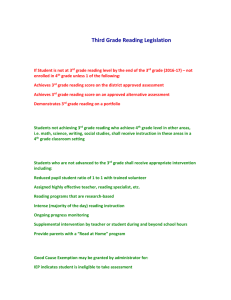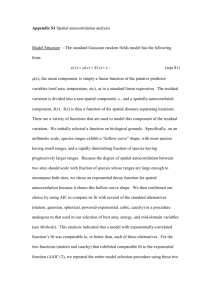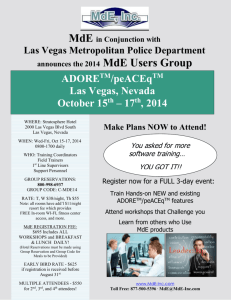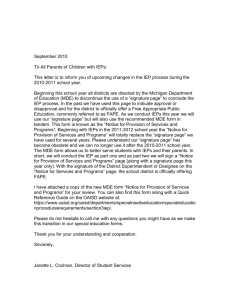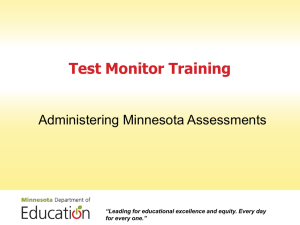Towards a Basic Theory to Model Model Driven Engineering
advertisement
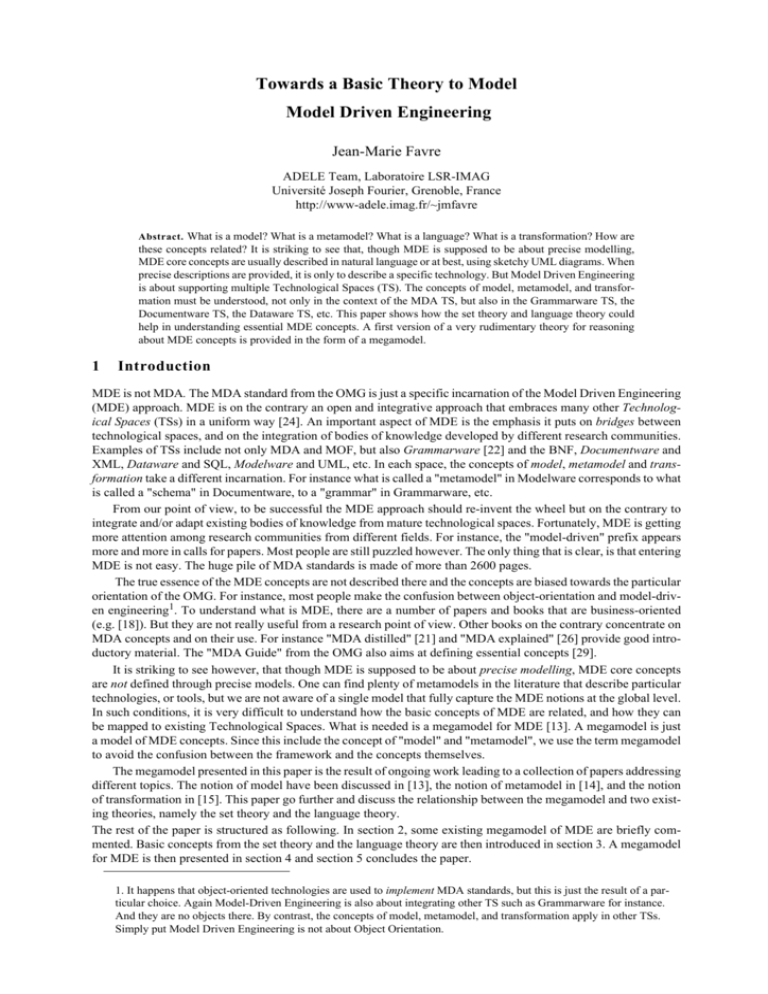
Towards a Basic Theory to Model
Model Driven Engineering
Jean-Marie Favre
ADELE Team, Laboratoire LSR-IMAG
Université Joseph Fourier, Grenoble, France
http://www-adele.imag.fr/~jmfavre
Abstract. What is a model? What is a metamodel? What is a language? What is a transformation? How are
these concepts related? It is striking to see that, though MDE is supposed to be about precise modelling,
MDE core concepts are usually described in natural language or at best, using sketchy UML diagrams. When
precise descriptions are provided, it is only to describe a specific technology. But Model Driven Engineering
is about supporting multiple Technological Spaces (TS). The concepts of model, metamodel, and transformation must be understood, not only in the context of the MDA TS, but also in the Grammarware TS, the
Documentware TS, the Dataware TS, etc. This paper shows how the set theory and language theory could
help in understanding essential MDE concepts. A first version of a very rudimentary theory for reasoning
about MDE concepts is provided in the form of a megamodel.
1
Introduction
MDE is not MDA. The MDA standard from the OMG is just a specific incarnation of the Model Driven Engineering
(MDE) approach. MDE is on the contrary an open and integrative approach that embraces many other Technological Spaces (TSs) in a uniform way [24]. An important aspect of MDE is the emphasis it puts on bridges between
technological spaces, and on the integration of bodies of knowledge developed by different research communities.
Examples of TSs include not only MDA and MOF, but also Grammarware [22] and the BNF, Documentware and
XML, Dataware and SQL, Modelware and UML, etc. In each space, the concepts of model, metamodel and transformation take a different incarnation. For instance what is called a "metamodel" in Modelware corresponds to what
is called a "schema" in Documentware, to a "grammar" in Grammarware, etc.
From our point of view, to be successful the MDE approach should re-invent the wheel but on the contrary to
integrate and/or adapt existing bodies of knowledge from mature technological spaces. Fortunately, MDE is getting
more attention among research communities from different fields. For instance, the "model-driven" prefix appears
more and more in calls for papers. Most people are still puzzled however. The only thing that is clear, is that entering
MDE is not easy. The huge pile of MDA standards is made of more than 2600 pages.
The true essence of the MDE concepts are not described there and the concepts are biased towards the particular
orientation of the OMG. For instance, most people make the confusion between object-orientation and model-driven engineering1. To understand what is MDE, there are a number of papers and books that are business-oriented
(e.g. [18]). But they are not really useful from a research point of view. Other books on the contrary concentrate on
MDA concepts and on their use. For instance "MDA distilled" [21] and "MDA explained" [26] provide good introductory material. The "MDA Guide" from the OMG also aims at defining essential concepts [29].
It is striking to see however, that though MDE is supposed to be about precise modelling, MDE core concepts
are not defined through precise models. One can find plenty of metamodels in the literature that describe particular
technologies, or tools, but we are not aware of a single model that fully capture the MDE notions at the global level.
In such conditions, it is very difficult to understand how the basic concepts of MDE are related, and how they can
be mapped to existing Technological Spaces. What is needed is a megamodel for MDE [13]. A megamodel is just
a model of MDE concepts. Since this include the concept of "model" and "metamodel", we use the term megamodel
to avoid the confusion between the framework and the concepts themselves.
The megamodel presented in this paper is the result of ongoing work leading to a collection of papers addressing
different topics. The notion of model have been discussed in [13], the notion of metamodel in [14], and the notion
of transformation in [15]. This paper go further and discuss the relationship between the megamodel and two existing theories, namely the set theory and the language theory.
The rest of the paper is structured as following. In section 2, some existing megamodel of MDE are briefly commented. Basic concepts from the set theory and the language theory are then introduced in section 3. A megamodel
for MDE is then presented in section 4 and section 5 concludes the paper.
1. It happens that object-oriented technologies are used to implement MDA standards, but this is just the result of a particular choice. Again Model-Driven Engineering is also about integrating other TS such as Grammarware for instance.
And they are no objects there. By contrast, the concepts of model, metamodel, and transformation apply in other TSs.
Simply put Model Driven Engineering is not about Object Orientation.
2
Existing megamodels of MDE
Let’s start with a definition of what is a model. "A model is a simplification of a system built with an intended goal
in mind. The model should be able to answer questions in place of the actual system." [5]. According to this definition, we can say that this paper is a model: MDE plays here the role of the system under study using Seidwitz’s
terminology [35]; this paper is obviously a simplification of MDE; the goal we have in mind is to give an overall
view on the MDE concepts. This paper is a model of MDE. So it is for [2][4][11][21][35], etc.
Some readers might be disagree though. Because in the context of MDE, some authors provide a more restrictive definition of models. In [21], Warmer and his colleagues state: "A model is a description of a (part of) systems
written in a well-defined language. A well-defined language is a language with well-defined form (syntax), and
meaning (semantics), which is suitable for automated interpretation by a computer" [21]. We have not found any
well-defined model of MDE in the literature. Just books, papers, ideas. Nothing that could be put in the computer
to get a useful result. MDE experts claim that models should be precise, but they just use plain english and informal
drawings to define what is MDE. For instance an attempt to provide a UML model for MDE was made in a previous
version of an OMG document [31]. Unfortunately, this was very informal and almost useless. As a matter of fact,
the UML diagrams were not used in the rest of the OMG document [31]. These diagrams were later removed in the
next versions. The need to reason about models, metamodels, transformations and their combination has not disappeared however. The "MDA explained" book [21] uses a simple yet appealing notation to depict these concepts and
their relationships. Though the pictures in the book are rather suggestive, they have no formal meaning.
By contrast, the "MDA distilled" book [26] provides a simple model of MDE expressed in UML.
The full model contains 11 classes and 17 associations. The figure on the left shows only the relevant part here. This megamodel constitutes one of
the strong contributions of this book. It greatly
helps the reader in understanding what are the important concepts of MDE and what are their relaFigure 1 "MDA Distilled" megamodel [26]
tionships. Unfortunately, this megamodel is not
fully consistent with the text, and worse, it provides wrong answers. For instance, according to the diagram above,
a metamodel is not a model and there is no such thing such as a meta-metamodel. Describing the metamodel of a
mapping function is not considered either, though this is considered as an important aspect in MDE. For instance,
the QVT standard will not fit in this schema, first because QVT is a language, and the concept of language is not
modelled here, and then because QVT is a language to express mapping functions, and there is no such class like
MappingFunctionLanguage. The reader might argue that QVT is a metamodel, but this is wrong. A language is not
a metamodel (section 4.1). In short, the "MDA Distilled megamodel" is wrong in the sense that it sometimes provides wrong answers about MDE. As a matter of fact, it is neither used nor validated in the rest of the book. Instead
of drawing instance diagrams to validate the class diagram above, examples are expressed using an informal notation with no explicit link with the megamodel.
All the megamodels we are aware are sketchy models. None of them describe MDE accurately. While these
models could be used to get simple answer to simple questions, they become useless to describe those situations
where informal reasoning is not enough. And this is precisely in such situations that precise modelling is required.
In fact, it is surprising to see that while everybody in the MDE community advocates for precise modelling, it seems
that no-one applies this principle to MDE.
3
From the set theory to the language theory
We are in the search of a basic theory for MDE; of something that can help in reasoning about MDE, not in simple
cases but in those situations where intuition is not enough. When things turn really complex, the best solution is to
use simple and elementary concepts and to deal with complexity by combining these simple concepts in regular
structures. Let’s forget everything about MDE technology and go back to some of the roots of Computer Science,
namely the set theory and the language theory. With this background in mind, a megamodel will then be presented
in section 4.
3.1
Elements from the set theory: Sets, Pairs, Relations and Functions
Though there are actually various "set theories", we use here simple concepts as defined in the Z language [36]. The
Z formulas below are not part of the megamodel. They just attempt to illustrate the concepts that will be included
in the megamodel. The concepts of interest here are sets (¡), pairs (²), relations (¨) which are basically set of pairs,
(partial) functions (©) which are relations, and total functions which are (partial) functions. The symbol == is used
in Z to define shortcuts. The last column give an example for each notation.
[X,Y]
£
¡X
X²Y
X¨Y
dom R
ran R
A©B
AªB
X and Y are "given sets", that is set of elements.
The set of positive integers. Built-in in Z.
The set of sets of X elements. ¡ can be read "set of".
The cartesian product of X and Y, that is a set of pairs.
The set of relations from X to Y, basically a set of pairs.
X ¨ X == ¡(X ²Y)
The domain of the relation R. (the set of elements with an image).
dom R = {x:X | ( Ö y:Y | (x,y) ³ R}
The range of the relation R.
dom R = {x:X | ( Ö y:Y | (x,y) ³ R}
The set of functions from A to B. At most one target for one source.
X © Y == {f: X¨Y | (Õx:X;y1,y2:Y | {(x,y1),(x,y2)}ºf Ûy=y2)}
The set of total functions from A to B.
X ¨ Y == { f : X © Y | dom f = X }
[RomanNumber]
1³£
{1,2,7} ³ ¡ £
(1,5) ³ £ ² £
{(0,1),(1,2),(1,3)}³ £¨£
dom{(0,1),(1,2),(1,3)}= {0,1}
ran{(0,1),(1,3)}= {1,3}
{(0,1),(1,3)}³ £©£
+ : £²£ª£
In fact a relation is not only a set of pairs. In mathematics, relations are often defined as a triple (X,Y,G) where X,
Y are sets, here called definition domain and definition range, and G is the set of pairs from X ² Y. In Z, when one
states div : £²£©£, then £²£ is the definition domain and £ the definition range of the div partial function. This
function is partial because the element (2,0) has no image: (2,0) is in the definition domain, but not in the domain.
The concepts from the set theory form
Kernel
one of the basis of our megamodel as
source *
element *
Shortcuts:
System
shown on the left. The content of the KerΤ : Takes
ε: ElementOf
target *
e : element
Υ : Yields
nel package will be explained in the next
s : source
dd : definition domain
AbstractSystem
t : target
section in Figure 5. Note that though the
dr : definition range
concepts from the set theory are modelled
SetTheory
here using the UML/OCL notation there
-- a relation is a set of pairs
ElementOf
element->forall( e | e.oclIsKindOf(Pair))
are by no way linked the UML. A set is a
set *
and
element.oclAsType(Set(Pair))->forall( p : Pair |
set, irrespective of the language it is exSet
-- the source of each pair is in the definition domain
self.defDomain.element->includes(p.source)
1 defRange
defDomain 1
pressed in. We use UML here because we
-the
target
of
each
pair
is
in
the
definition
range
Yields
Takes
and self.defRange.element->includes(p.target))
assume that most people can read this di*
*
Pair
Relation
agram. At the time of writing this paper
-- only one target for a given source
element.oclAsType(Set(Pairs))->forall( p1,p2: Pair |
we are also developing other megamodels
p1<>p2 and p1.source=p2.source
implies p1.target <> p2.target)))
Function
with the same meaning but expressed in
Prolog, in Z, and in Hieroglyphics [34].
Figure 2 SetTheory package
All these languages are just used as notations, and we carefully avoid to mix the megamodel concepts with those that come from the language used. For
instance in the UML megamodel, the ³ concept is represented as standard UML association named ElementOf, not
the as the built-in ->includes OCL expression. In Prolog, it becomes the elementOf predicate, not the built-in member
predicate. In Z this is a relation named ElementOf, not the built-in ³ symbol. Finally it becomes the
ideogram
in hieroglyphics [34].
The good way to test a UML model is to describe object diagrams showing particular situations. This is the only
way to get reasonable confidence in a MDE megamodel. A model might be good enough, until it is shown that it
provides bad answers in a given situation. We have built simple test cases that acts as counter examples to show the
invalidity of existing megamodels and none pass the tests.
Object diagrams can also be used to illustrate MDE concepts romanNumber:Set defDomain f:Function
defRange £:Set
by considering particular situations. The object diagram
ElementOf
ElementOf
ElementOf
shown in Figure 3 conforms to the UML language. This
source
target
model describes the fact that a function called f maps the IV
IV:System
p:Pair
four:System
roman number to the integer number four. The top part of
Figure 3 A model representing f(IV) = four
Figure 3 describes the function itself, while the bottom part
is the application of the function to a particular value (it states f(IV) = four). Figure 3 is fully compliant with UML.
The same information can be represented in other ways (Figure 4): (1) using the Z language to specify this particular
situation, (2) using the megamodel in Prolog (symbols in bold are part of the Prolog megamodel), and (3) using the
megamodel in Z (symbols in Z are parts of the Z megamodel).
(1)
[romanNumber]
iv : romanNumber
f : romanNumber © £
f(iv) = 4
(2)
Figure 4
function(f).
takes(f,romanNumber)
yields(f,n)
elementOf(pair(iv,four),f)
(3)
The "f(IV) = four" model in various languages
romanNumber,f,n,iv,four : System
f ³ Function
(f,n) ³ Yields
(iv,four) ³ Pair
((iv,four),f) ³ ElementOf
The reader might have noticed that there is more information in the UML object diagram than the prolog facts. Some
facts have been omitted because they can be automatically deduced thanks to the set theory, which is in fact encoded
in each megamodel. For instance the fact elementOf(iv,romanNumber) can be derived by the prolog megamodel. Note
that this information could also be derived from the UML megamodel, because this model describes the same rule.
However, the benefit of the prolog megamodel is that it is executable.
Finally note that though the notion of model is not part of the set theory, this notion can be found implicitely in
languages that deal with this theory. For instance the Z language introduce the notion of "definition".
Set definitions by comprehension
Relation definitions by comprehension
Function definitions by comprehension
{ x : £ | (x+2)2>4 }
{ (x,y) : £²£ | y>x }
õ x : £ × n+1
{x:£|xµ0 }
{ (x,y) : £²£ | x<y }
In fact the expressions given above can be considered as models. For instance { x : £ | (x+2)2>4 } is a model representing a set, it is not the set. They are plenty of other models that represent this set.
3.2
Elements from the language theory: Languages, Programs, and Interpreters
There is no such thing such as "the definitive language theory", but let’s introduce here some of the concepts that
are traditionally defined when dealing with programming languages. The relationship between the set theory and
the language theory was further described in [17]. Here we will continue to use Z for illustration purposes.
A language is a set, at least according to people from the Grammarware community. For instance RomanNumber is
the language of numbers used by Romans. Similarly Java is the set of all java programs. {"a","ab"; "abb", "abbb",
"abbbb", ...} is the language of the strings that start with an "a" and then continue with some "b". Since languages are
usually infinite, reasoning with these languages require to deal with models of languages. The string "ab*" is a model
of the language described above. Grammars are models of languages, they are not languages.
Programming languages are languages of programs, that is sets of programs, where each program is an executable
model of a function. Not all models of a function are executable. For instance the following signature of a C function
"int power(int a, int b)" is a model of that function, but it cannot be executed. If a model of a function is executable, then
it is called a program. Before to continue let’s introduce a simple programming language called RomanStackPL. This
programming language implements a stack machine with push and pull operations and incr, add and mul arithmetic
operations. Programs take a stack of roman numbers as input and yield a stack.
[RomanStackPL,RomanStack]
Plus1Fun : RomanStack © RomanStack
{"incr", "push I; add", "add;push II;mul"} º RomanStackPL
{ "LX.", "LXI.", "II-I.", "III-I.", "I-IV-III.", "X-III." } º RomanStack
{ ("LX.","LXI."), ("II-I,"III-I."), ("I-IV-III.","II-IV-III.") } º Plus1Fun
The function Plus1Fun adds one to the first element of the stack. With the programming language above, there are
at least two programs that model this function "incr" and "push I; add". These programs are semantically equivalent.
An interpreter function of a programming language is a function that takes a program with an input value and that
returns an output value that corresponding to the result of the execution of the program. Interpreter functions of a
programming language L that allows to describe programs that transforms Xs into Ys are therefore characterized by
the following pattern: (L ² X) © Y. An example is given below to show that an interpreter function is a mathematical
object.
InterpreterPLFun[L,X,Y] == (L ² X) © Y
{(("incr","LX."),"LXI."), (("incr","II-I),"III-I."), (("incr","I-IV-III."),"II-IV-III."), ...
(("add;push II;mul","II-I.","VI.")) , (("add;push II;mul","I-IV-III."),"} ... }
³ InterpreterPL[FunRomanStackPL, RomanStack, RomanStack)]
4
Towards a theory for MDE
Now that basics of the set and language theories have been introduced, let’s define a megamodel for MDE.
4.1
Megamodel infrastructure
Let’s start with the infrastructure of the megamodel which
is totally technology independent. The main package of the
infrastructure is shown in Figure 5. So far only mathematical entities have been considered. They are special cases of
Abstract Systems. The relationship between the Kernel
package and the SetTheory has been shown in Figure 2. Abstract systems are those processed by human minds.
By contrast the dog Fido, which is often cited in the metamodeling literature, is an example of Physical System. MDE
aims at building better computer programs and better com-
Kernel
model *
* composite
RepresentationOf
System
sus *
DecomposedIn
* part
{incomplete}
PhysicalSystem
Shortcuts:
µ: RepresentationOf
δ: DecomposedIn
DigitalSystem
AbstractSystem
sus : systemUnderStudy
c : composite
p : part
Figure 5 Excerpt of Kernel
puter model. They are Digital Systems. This raw classification is not really important [13]. It is just used to show
that the term System (we could have used any other term) cover a very wide range of artefacts.
Since a system could be a complex thing, it can be decomposed in many parts (Figure 5). A system can play the
role of model with respect to another system, which then play the role of system under studies (Figure 5) [13][35].
This relation, called RepresentationOf (µ for short), have been identified by many authors (e.g. [2][4][35]).
The concept of transformation is also fundamental to MDE. The definiSetTheory
tion of this concept can be based on the set theory because the concept
Pair
Function
of relation is clearly a good abstraction for transformations. There is no
consensus however about what is a transformation precisely. The meanTransformation
ing of this term depends on who use it. Many concepts that are closely
TransformationInstance TransformationFunction
related, but that are distinct, can be put under this common terminology.
For instance the package Transformation contains the concepts of
elements->forall(e|
e.oclIsKindOf(TransformationInstance))
TransformationInstance and TransformationFunction (Figure 6). Figure
5 and Figure 6 are linked by the fact that Pairs and Functions are AbFigure 6 Excerpt of Transformation
stractSystems as shown previously in Figure 2. We call TransformationInstance the application of a transformation to a particular input. By contrast TransformationFunctions are
functions, and therefore sets of TransformationInstances. Thanks to the set theory, these concepts can be clearly
defined. The goal of this paper is not to normalize the terminology, but to make explicit the existence of each concept. In fact, it is not strictly necessary to define the class TransformationFunctions. Formally speaking, this class
does not convey more information that the invariant associated with this class. Introducing this class just gives a
convenient way to refer to a particular role played by a Function in a pattern. We discovered that they are indeed a
lot of interesting MDE patterns. Simple yet very common patterns are presented in [15]. The next section shows
more elaborated patterns based on the theories described above.
4.2
MDE patterns
The reader might be surprized to see that until now, no mention was made to the notion of metamodel. This is because this is indeed a derived concept [14]. A metamodel is a model of a language of models. This definition is compatible with those found in the literature (e.g. [35]).
transformation
The meta-step pattern. The metamodel concept corresponds to a role played
µ
by a system in a MDE pattern coined meta-step. This pattern is discussed at
large in [14]. As shown on the left of Figure 7 is based on a particular configu∈
χ
µ
µ
ration of two µ−links (Kernel::RepresentationOf) and one ε−link (SetTheo- χ
ry::ElementOf). A model Conpattern
Kernel
formsTo (χ) a metamodel. This
Figure 7 The "meta-step"
metamodel
derived association is commonly
Shortcuts:
pattern and transformation rule
System
*
χ : ConformsTo
used in MDE [4][35], so it makes
/ConformantTo mm : metamodel
sense to defined it in the Kernel package. This definition can also be
*
cm : conformantModel
seen as a transformation rule (Figure 7). Most of the time, representing
conformantModel
χ links in common situations is enough.
A pattern of model transformation. The pattern depicted
transformationMetamodel
in Figure 8 corresponds to the notion of model transformation. The names of the instances have been used here to
µ
χ
transformationModellingLanguage
name the role played by each element in the pattern. As sug∈
gested by the figure, one can distinguish transformation insourceMetaModel
targetmm
transformationModel
stances (e.g. an XML file transformed into another XML
µ
µ
µ
file), transformation functions (e.g. a set of somehow relatdr
χ sourceLanguage dd transformationFunction
targetLanguage
χ ed pairs), transformation models (a description of a func∈
∈
∈
tion, also called transformation program if it is executable,
s
t
sourceModel
transformationInstance
targetModel
e.g. a XSLT file), transformation modelling language or
transformation programming language if it can be executed
µ
µ
system
(e.g. XSLT), transformation metamodel (e.g. the DTD of
Figure 8 A typical pattern of model transformation XSLT). In fact many other concepts could have been added
in this figure using other links, but the approach is the same.
The interpreter pattern. A transformation program is a
transformation model that can be executed. This leads to the "interpreter pattern" (Figure 9.a). The detailed description of this pattern is quite complex, and recognizing such pattern mentally is not easy. Fortunately one can define
some derived associations (in bold in Figure 9.a) including the LanguageTheory::Interprets relation (ι). Complex
graphs can be simplified by applying for instance the rule shown in Figure 9.b. This leads to much more intuitive
but still safe views. Figure 9.c illustrates the application of the simplification rule. It shows the various levels of
interpreter
µ
dd
δ
∈
il
progrlang
s
δ
δ
δ
pi
Shortcut:
ι
interperterFunction
∈
∈
ι
i386
ipl
ipl
prog
xsl
µ
fun
∈
s
(a) interpreter pattern
dr
dr
t
∈
ipl
ι
t
pi
prog
ι
javainterp
ι
∈
xerces
∈
interpreter
po
i386processor
∈
java
dd
∈
: Interprets
ipl : interpretedProgrammingLanguage
pi : programInput
po : programOutput
x1.xml
pi
ι
t.xsl
po x2.xml
po
(b) example of simplification rule
(c) example of a stack of interpreters
Figure 9 The "Interpreter Pattern"
interpretation required by the effective execution of an xslt transformation instance on a computer. This is a real
world problem. The stack of interpreters stops at the end because the i386 interpreter is PhysicalSystem.
4.3
Megamodel superstructure and technological spaces
The megamodel infrastructure presented so far is technology-free. In [34],
Infrastructure
it is shown how it can be applied to real-word situations from Ancient
Egypt to modern world. The megamodel is not limited to digital systems,
Kernel
* metamodel
though this is the focus of our research. The megamodel infrastructure
System
ConformsTo
plays the role of a common umbrella under which various technological
*
spaces can be described. The relationships between the megamodel infraSuperstructure
structure and the superstructure containing TSs-dependent megamodels
should be made explicit. Defining the superstructure, that is modelling TSs
ComputerTS
of interest is not an easy task. More research is required to study the real
DigitalSystem
nature of TSs and their relative organizations [24], but defining the mapOS
pings Infrastructure <-> TSs seems to be a very promising approach.
File
Showing how particular TSs could be integrated in the megamodel is also
a very good point to communicate with other research communities, beXMLTS
cause the megamodel provides a concrete mean to establish terminology
*
XMLFile
XSDReference
correspondences across TSs. Establishing a complete software engineering
map is obviously a huge work, but we started with a few examples for the
metamodel =
0..1
XSDFile
schema->asSet
proof of concept and for teaching purposes. As an example Figure 10 conschema
siders the relationship between the XMLWare Technological Space and
the infrastructure. It shows the relationship between the χ association
Figure 10 Simplified mapping
which is the abstract concept and "references to XSchema files" (.xsd)
Infrastructure <-> XML TS
which is one of its incarnation in the XML TS. From a very concrete point
of view, such a reference is represented in an XML file as an XML attribute
of the form xsi:schemaLocation="s.xsd".
4.4
Towards a basic MDE theory
The diagrams presented in this paper describe the megamodel, but where is the theory mentioned in the title of this
paper? The relationship between models, metamodels and theories is described in [35]. According to Seidwitz, "A
model is a set of statements about some system under study (SUS). ... A theory is a way to deduce new statements
about a SUS from the statements already in some model of the SUS.". While this relationship between the megamodel and a theory for MDE might not be apparent with the UML incarnation, it becomes much more clear with the
Prolog incarnation. As shown in the centre of Figure 11, the Prolog MDE megamodel is an executable program. It
can deduce new facts about a particular MDE situation such as the one modelled on the left of Figure 11. The excerpt of the megamodel in the center shows the translation the meta-step pattern presented before. The power of
Prolog can be used to ask questions and get answers (right of Figure 11).
representationOf(aUmlModel,aSystem).
representationOf(umlMetaModel,uml).
representationOf(mofMetaModel,mof).
elementOf(aUmlModel,uml).
elementOf(umlMetaModel,mof).
elementOf(mofMetaModel,mof).
A model for a particular MDE situation
conformsTo(M,MM) :representationOf(M,S),
elementOf(M,L),
representationOf(MM,L).
metamodel(MM) :conformsTo(M,MM).
Excerpt of the megamodel Kernel package
conformsTo(X,Y) ?
X=aUmlModel
Y=umlMetaModel
X=umlMetaModel Y=mofMetaModel
X=mofMetaModel Y=mofMetaModel
metamodel(mof) ?
no.
Asking questions and getting answers
Figure 11 Automated reasoning about MDE
4.5
Discussion
Building a model is not easy when the system is complex. Thousands of years were necessary before to get a correct
map of the world. Model Driven Engineering is a moving field and there is a lot to say about it. Building a good
model for it is complex research issue, but this could be a rewarding task. First experiments are very encouraging
and we were quite surprised of the results that can be get thanks to this very simple approach.
Our approach consists in introducing concepts incrementally, trying at each step to add only truly essential concepts. At each step we take care of developing examples either from computer technology or real world to check
the validity of the theory. Over the last years we have accumulated hundreds of metamodels from many different
sources. This "metamodel zoo" is used as the basic material to understand how people from different communities
use metamodelling techniques, and they are in fact great variations. Our metamodel zoo acts as basic material to
test the megamodel. Conversely, the megamodel provides a way to organize the metamodel zoo, but further research is required on this topic.
All this is ongoing work, and the megamodel presented in this paper is subject to many refinement. For instance
the notion of conformance is very weak here, but this is on purpose. We are defining various other kinds of more
elaborated conformance relations, but this require the introduction of the notions of syntax, semantics and so on.
This very abstract vision of reality might give the false impression that these concepts are disconnected from
reality, but this is not the case. For instance the conformance relations are typically checked by actual tools such as
LanguageRecognizers or Parsers. All these concepts can be described in the megamodel. A very important requirement during the design of the megamodel was to give the ability to extend it to suit the needs of particular technological spaces. Another interesting aspect of the approach proposed here is that it allows to compare existing MDE
techniques and tools with a common framework. Other concepts such as the notion of platform are really ill-defined
and we are not sure that they should be included in the megamodel. May be they are simply wrong concepts but
more research is required.
5
Conclusion
Though MDE experts advocate for the use of precise modelling, it is striking to see that MDE concepts are usually
described only in plain english with sketchy informal pictures. The few UML models we have found are quite suggestive but they don’t pass the tests. They often give wrong answers. In fact, it seems that none of these models have
been seen as a way to build consistent instance diagrams. This is a pity, because a design which is not tested will
invariably be thrown away, sooner or later. We strongly believe that the future of MDE is not necessarily in adding
yet another complex technologies on top of already complex technology layers. On the contrary, instead of building
(again) new tools from scratch and entering legacy-MDA very soon, it could be wise to learn from the past. The
identification of Technological Spaces is fundamental with this respect. Again, MDE is not MDA. MDE is about
integrating in a smooth way existing and mature bodies of knowledge. But this could be done only with a shared
understanding. And one could not expect researchers from other community to enter the MDE space if MDE concepts are not properly identified. The set theory and language theory are parts of the lingua franca in Computer Science, so using these concepts can greatly help in identifying bridges with existing TSs. In fact, by using the megamodel to model real world situations we discovered that it was much more powerful than we had expected. It really
helped us to connect concepts and technologies that were apparently disconnected. The introduction of the set theory had been decisive in this process. Surprisingly we discovered on the run a lot of interesting patterns and we are
still discovering new ones. We are still very far from a sound and complete theory for MDE. This paper has only
scratched the surface of the topic. Let’s hope however that this very little step towards a better understanding of
MDE could be helpful to others.
6
Acknowledgments
We would like to thank Jacky Estublier, German Vega, Jean Bézivin, and all members of the AS MDA project, as
well as attendee of the MDE Dagsthul Seminar 1401 for the fruitful discussions we had on these topics.
7
[1]
[2]
[3]
[4]
[5]
[6]
[7]
[8]
[9]
[10]
[11]
[12]
[13]
[14]
[15]
[16]
[17]
[18]
[19]
[20]
[21]
[22]
[23]
[24]
[25]
[26]
[27]
[28]
[29]
[30]
[31]
[32]
[33]
[34]
[35]
[36]
[37]
References
D.Akehurst, S. Kent, "A Relational Approach to Defining Transformations in a Metamodel", LNCS 2460, UML 2002
C. Atkinson, T. Kühne, "Model-Driven Development: A Metamodeling Foundation", IEEE Software, September 2003
J. Bézivin "From Object Composition to Model Transformation with the MDA"
J. Bézivin, "In Search of a Basic Principle for Model-Driven Engineering", Novatica Journal, Special Issue, March 2004
J. Bézivin, O. Gerbé, "Towards a Precise Definition of the OMG/MDA Framework", ASE’01, November 2001
J. Bézivin, E. Breton, G. Dupé, P. Valduriez, "The ATL Transformation-based Model Management Framework", TR0308, University of Nantes, September 2003
J. Bézivin and al, "First experiments with the ATL model transformation language: Transforming XSLT into XQuery"
G. Caplat, J.L. Sourrouille,"Considerations about Model Mapping", Wisme 2003
DSTC, IBM, "MOF Query/View/Transformations", Initial Submission by DSTC IBM, ad/2003-02-03, March 2003
IEEE. "IEEE Recommended Practice for Architectural Description of Software-Intensive Systems". IEEE Std 1471-2000,
http://www.pithecanthropus.com/~awg/public_html/
J.M. Favre, "Meta-models and Models Co-Evolution in the 3D Software Space", ELISA 2003, with ICSM, Sept.2003,
www-adele.imag.fr/~jmfavre
J.M. Favre, "CacOphoNy: Metamodel-Driven Architecture Reconstruction", WCRE 2004, November 2004
J.M. Favre, "Foundations of Model (driven) (Reverse) Engineering - Episode I: Story of the Fidus Papyrus and the Solarus", post-proceedings of Dagsthul Seminar on Model Driven Approaches for Language Engineering, May 2004, in [34]
J.M. Favre, "Foundations of Meta-Pyramids: Languages and Metamodels - Episode II: Story of Thotis the Baboon", postproceedings of Dagsthul Seminar on Model Driven Approaches for Language Engineering, May 2004, in [34]
J.M. Favre, T. NGuyen, "Towards a Megamodel to Model Software Evolution Through Software Transformation", SETRA Workshop, Elsevier ENCTS, October 2004
J.M. Favre, and al., "Reverse Engineering a Large Component-based Software Product", CSMR'2001
J.M. Favre, "Maintenance et Rétro-ingénierie globale des logiciels", PhD, University of Grenoble, 1996
D.S. Frankel, "Model Driven Architecture. Applying MDA. to Enterprise Computing", Wiley Publishing,
M. Griffiths, "Analyse déterministe et compilateurs", PhD, University of Grenoble, 1969
S.R. Judson, R.B. France, D.L. Carver, "Specifying Model Transformation at the Metamodel Level", Wisme 2003
A. Kleppe, S. Warmer, W. Bast, "MDA Explained. The Model Driven Architecture: Practice and Promise", AddisonWesley, April 2003
P. Klint, R. Lämmel, C. Verhoef, "Towards an engineering discipline for Grammarware", submitted for publication, available at http://homepages.cwi.nl/~ralf/
I. Kurtev, K. van den Berg, "A Synthesis-Based Approach to Transformations in an MDA Software Development Process
I. Kurtev, J. Bézivin, M. Aksit, "Technological Spaces: an Initial Appraisal", CoopIS, DOA'2002, Industrial track, 2002
T.Levendovszky and al, "Model Reuse with Metamodel-Based Transformations", ICSR-7, LNCS 2319, 2002.
S.J.Mellor, K.Scott, A.Uhl, D.Weise, "MDA Distilled: Principles of Model-Driven Architecture", Addison Wesley,
March 2004
M. Peltier, "Techniques de transformations de modèles basées sur la méta-modélisation", PhD, University of Nantes, October 2003
M. Peltier, M. Ziserman, J. Bézivin, "On levels of model transformation", XML Europe, June 2000
OMG, "MDA Guide Version 1.0.1", omg/2003-06-01, June 2003
OMG, MDA Web Site, www.omg.org/mda
OMG, "OMG, "Model Driven Architecture (MDA)", ormsc/2001-07-01, July 2001
OMG, "Meta Object Facility (MOF) Specification" Version 1.4, April 2002
QVT-Partners, "Revised Submission for MOF 2.0 Query / Views / Transformation RFP", http://qvtp.org, August 2003
Series "From Ancient Egypt to Model Driven Engineering", available at http://www-adele.imag.fr/mda
E. Seidewitz, "What Models Mean", IEEE Software, September 2003
J.M. Spivey, "The Z notation: A Reference Manual", Prentice Hall, 1992
E.D. Willink, "UMLX : A graphical transformation language for MDA", MDAFA 2003

